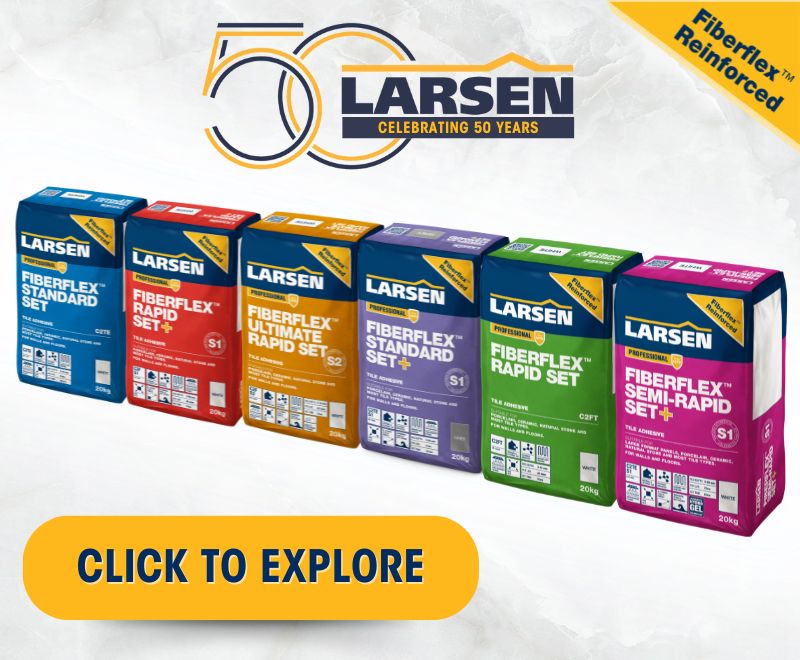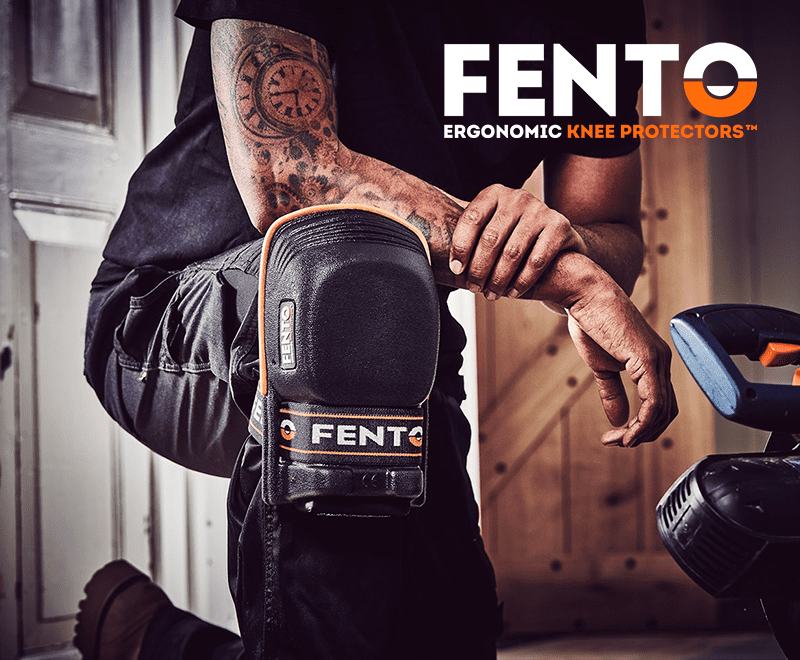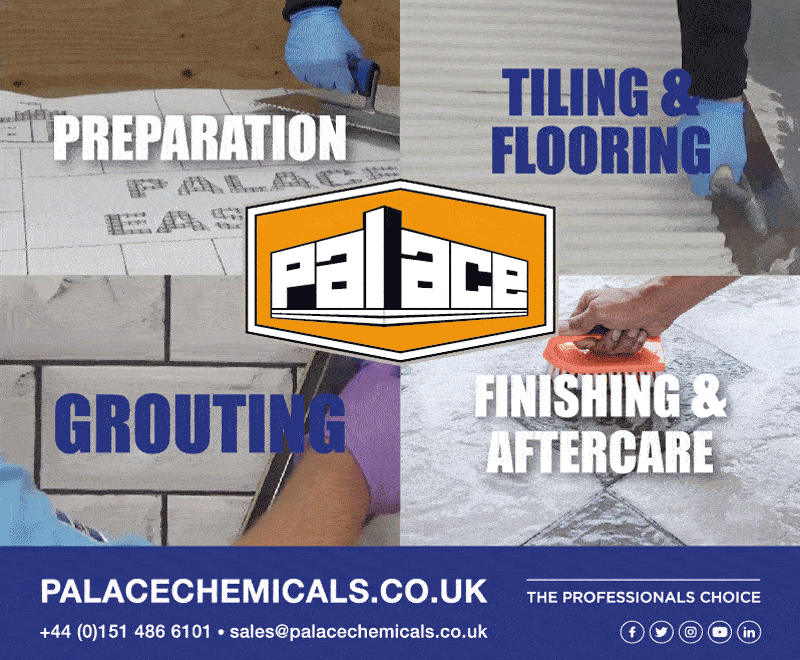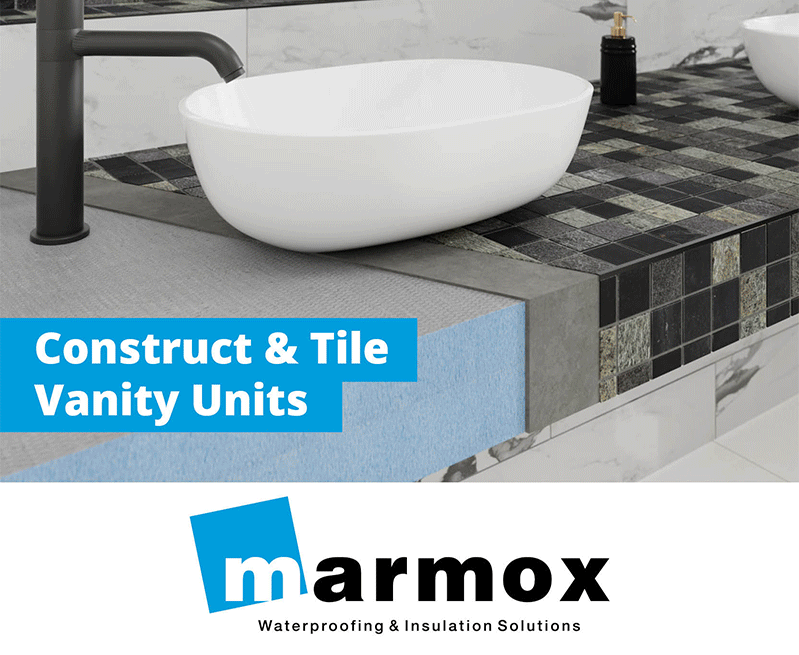Bradley Cutts, ARDEX training and technical support manager provides a guide to concrete and screed repair preparation
IN professional tiling, the condition of the substrate is as critical as the tile itself. Concretes and screeds, while robust, are often compromised by environmental and site exposure, mechanical damage, or poor workmanship.
Before any tile installation, the substrate must be structurally sound, dry, and free of surface contaminants.
This article outlines a systematic approach to concrete and screed repair using high-performance materials and techniques suitable for professional tilers working on commercial and residential projects.
Understanding substrate requirements
Tiling over compromised concretes and screeds can result in adhesive failure, tile cracking, and moisture-related issues. BS 5385 and BS 8204 standards emphasise the importance of substrate preparation. Key requirements include:
– Surface integrity: no loose material, laitance, or dust
– Flatness and level: typically, SR1 surface regularity ±3mm over 2m for floor tiling
– Moisture control: relative humidity below 75% unless using moisture-tolerant systems
– Compressive strength: typically, C25/30 for concrete and C20 or C25 for cementitious screeds.
Repairing surface damage and defects
Surfaces often exhibit defects such as spalling, honeycombing, frost damage and edge damage. These must be addressed using polymer-modified repair mortars that offer:
– High bond strength to concrete and masonry
– Rapid curing to minimise downtime
– Thixotropic properties for vertical and overhead applications
For deeper repairs up to 50mm, slump-free mortars or floor screeding materials are preferred, applied using bonding agents. These can be applied without formwork and are suitable for internal and external environments.
For surface imperfections on vertical concrete surfaces renders provide a smooth finish suitable for subsequent coatings or adhesives.
Crack treatment and structural stabilisation
Cracks in concrete and cement-based screeds pose a significant risk to tiled finishes. Non-structural cracks on floors should be treated using low-viscosity resin systems that penetrate and seal the fissure. Where stitching techniques may be needed, use stainless steel pins embedded in epoxy resin. For structural cracks or movement joints, tilers must consult with structural engineers.
Levelling and resurfacing floors
Uneven surfaces require levelling and smoothing compounds that can be applied from feather edge to 20mm or more.
Levelling compounds should be selected based on the specific requirements of the project or installer including, depth required, drying time, compatibility with tile adhesives, and whether or not the substrate has a functioning DPM (damp proof membrane).
Fast-track systems allow tiling within hours, reducing project timelines. Some ultra quick drying compounds can receive tiles within the hour.
Moisture management and damp proofing
Moisture is a critical factor in tiling success. In substrates with residual construction moisture or no functioning DPM, surface-applied moisture barriers are essential. These systems typically consist of:
– Epoxide or polyurethane membranes that tolerate high RH levels (up to 98%)
– Single-coat application for rapid installation
– Compatibility with cementitious adhesives and levelling compounds
Screed consolidation and strengthening
In refurbishment projects, existing screeds may lack the required strength or cohesion. Penetrating resin systems can be used to consolidate weak screeds, improving their compressive strength and surface integrity. These systems:
– Penetrate deeply into porous substrates
– Cure rapidly, allowing tiling within hours
– Achieve soundness Category A as per BS 8204-1
Treatments such as penetrating screed repair systems are particularly useful in overnight renovations or where screed replacement is impractical.
Surface preparation and priming
Before tiling, all repaired surfaces must be properly prepared. This includes:
– Mechanical abrasion to remove laitance, all barriers to adhesion and open the surface, exposing the aggregate within the concrete or screed
– Vacuuming to remove dust and debris
– Priming, where required, to enhance adhesion and reduce porosity
Primers should be compatible with the substrate, the smoothing and levelling compound and adhesive system. In some situations, (e.g. no functioning DPM present), it’s not advised to prime, but simply to dampen the surface with water before applying repair mortars and levelling compounds, but this must be verified with the manufacturer’s technical data.
System compatibility and sequencing
A successful concrete or screed repair and tiling installation depends on the compatibility of all materials used. Tilers should ensure:
– Repair mortars, smoothing and levelling compounds, moisture barriers, and adhesives are chemically and physically compatible
– Curing times are respected to avoid premature tiling
– Environmental conditions (temperature, humidity) are within specified limits
Sequencing is also critical. For example, moisture tolerant smoothing compounds and crack repair systems are usually required and installed before surface applied DPM materials. Once DPMs are applied and moisture is controlled, grip primers are applied (within specific time periods) before applying a suitable tile adhesive.
Precision in preparation
Concrete and screed repair prior to tiling isn’t merely a preparatory step – it’s a technical process that underpins the durability and performance of the entire installation. Professional tilers and contractors must adopt a systematic approach, use high-performance materials and adhere to industry standards. By doing so, they ensure:
– Long-term adhesion, cohesion and tile integrity
– Reduced risk of failure and product misuse
– Efficient project delivery and reduced costs.
In an industry where reputation is built on reliability and finish quality, mastering concrete and screed repair systems is essential. Whether working on commercial refurbishments or high-end residential projects, tilers who invest in substrate preparation are those who deliver excellence.
For more information on concrete repair and substrate preparation, please consult the ARDEX Group technical helpline, or call your local ARDEX Group training and technical support manager.
03330 030160
info@ardex.co.uk
www.ardex.co.uk











